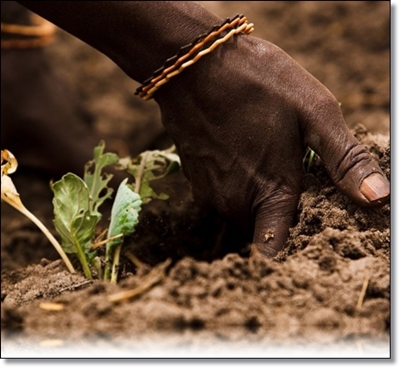The State of Uganda’s Soils

 |
Soil degradation costs the economy of Uganda UGX 225 billion per annum (NDP2). A number of National Development Plan phase two (NDP2) background documents isolate soil degradation as the major threat to declining arable land and achieving of middle income status. Degraded lands are one of the most singular push factors for increasing migrations of especially crop farmers in Uganda. Besides Uganda’s impressive headline growth, the challenges of hunger and malnutrition remain. The United Nations Food and Agriculture Organization (UN FAO) reports that nearly 240 million people or 1 in every 4 persons in Sub Saharan Africa (SSA) lacks adequate food. Over 200 million suffer debilitating symptoms of chronic to severe malnutrition, which also contributes to more than half the deaths of children below 5 years. This dichotomy reiterates the general finding of the 2014 progress report that economic growth in Africa has not been inclusive.
In addition to raging poverty, malnutrition, the youth bulge and unemployment, climate change and its impacts on the agriculture sector - a source of food but of employment to 60% of Africa’s labour - further compounds Africa’s outlook. Africa is reported by the IPCC AR4 as among the most vulnerable regions to climate change. Because of climate change, the World Bank reports that in SSA, by the 2030s, droughts and heat will leave 40% of the land now growing maize unable to support the crop, while rising temperatures could cause major loss of savannah grasslands, thereby threatening pastoral livelihoods. The implication is that by 2050, depending on the sub-region, the proportion of the population undernourished is projected to increase by 25 – 90% compared to the present. This will cascade onto labour availability and productivity and intensify poverty.
The current commercial agriculture narrative in Uganda involves massive land clearing that potentially degrades land through cutting trees and clearing vegetation thus exposing it to erosion, loss of biodiversity and kills insect pollinators. Land fragmentation driven by cultural practices is worsening the situation. On land clearing alone, the threat of conventional farming systems on forest ecosystems in Africa is manifest. Between 2000 and 2010, up to 13 million hectares of forest were cleared annually in Africa, primarily to expand land for food and fuel. Going forward, deforestation is projected to increase, with an additional 120 – 140 million hectares being converted by 2030, much of it in Latin America and Sub Saharan Africa, primarily for food production. Comparatively, Kenya has registered yield declines on 40% of crop lands, while South Africa has registered a 41% decline of crop yields due to land degradation associated with conventional farming systems. In Ethiopia, the forest cover declines by 1% annually due to unsustainable use of forest resources. Uganda’s forest cover has diminished from over 11m hectares in 1890 to below 3million hectares.
Sub Saharan Africa (SSA) reportedly has the world’s lowest crop yields, with cereal yields of 1.5 metric tons per hectare reported in 2011, being roughly 50% of the world’s average. With low yields on one hand coupled with a growing population on the other, SSA is compelled to meet a significant amount of its food demands through imports. Besides a food import bill of USD 35 billion incurred in 2011 (excluding fish), in 2010, Africa imported 14% of its animal products, 25% of cereals and 66% or two thirds of its vegetable oils. As of 2013, it was reported that SSA relies on imports for approximately 20% of its staples.
Beyond the soils, Uganda and Africa will have to tackle post-harvest losses (PHL) through investment in handy technologies and farmer awareness. For example SSA loses food worth USD 4 billion annually, food enough to feed 48 million people annually. PHL accounts for up to 67% of the total food lost in SSA, attributed mainly to inadequate financial and structural resources for proper harvesting, storage and transportation, as well as unfavourable climatic conditions for food preservation. Africa’s cumulative grain PHL’s range between 10 – 23%, with field losses at 4 -8%, storage, both at farm and market at 9%, and total transport losses going up to 6%. As an absolute figure, it is estimated that the annual PHL’s in cereal grains, roots, tubers, fruits, vegetables, meat, milk and fish for SSA were valued at more than USD 48 billion in 2010. When juxtaposed with Africa’s USD 35billion food import bill, recovering these losses would essentially eliminate the need for imports without increasing production. So why is Africa not investing in value addition and PHL management?
Reversing the losses means recovery of finance, job opportunities in the processing industries as well as buffering food security. Africa will hold conversations on these issues during the 2nd Africa Ecosystem based Adaptation for Food Security Conference 2015 in Nairobi from July 30th – 31st under the theme; Africa Soil or Oil: Re-imagining Africa Food security through working with nature and not against it now and into the future.
The foundation of food security - which is ecosystems - has not been given the same attention in comparison to oil. Looking at how investment into this sector with revenues from all corners including oil revenue starting today and into the future is the key. We must also keep reminding ourselves that the oil will run out but the ecosystems will stay if they are better managed and hence continue to provide the services that underpin agricultural productivity as well as reduce poverty and create jobs. The Ugandan contingent must go to these conversations with an open mind. Uganda needs a streamlined soil policy and a post-harvest handling strategy with resources going through organized farmer groups and cooperatives.
By Morrison Rwakakamba
Chief Executive Officer, Agency for Transformation, a Think and Do Tank based in Kampala, Uganda; http://www.agencyft.org/ mrwakakamba@gmail.com
